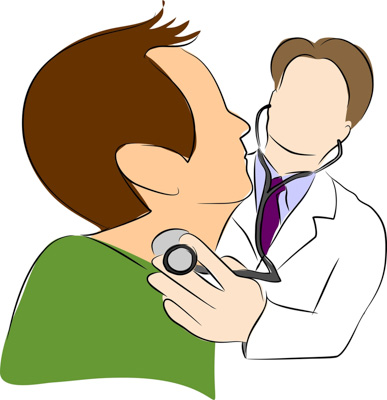Carotid Bruit - Auscultation Course

Carotid Bruit Sounds Overview
This course extends auscultation skills by presenting carotid bruit sounds.
A bruit (pronounced 'broo-ee') is a vascular, whooshing sound, caused by turbulent blood flow in an artery which supplies blood to the brain. Increased stenosis of a carotid artery results in increased duration, intensity, and pitch of the bruit.
What Does A Carotid Bruit Sound Like?
Carotid bruit sounds and a basal heart murmur are easily confused. Because the sounds radiate throughout the body, a heart murmur will be heard, with reduced intensity, at the auscultation points above the clavicle and a carotid bruit will be heard (again with reduced intensity) at the auscultation points below the clavicle. If the intensity of sound is greater above the clavicle, it is most likely a carotid bruit. If it is louder below the clavicle, it is most likely a heart murmur.
How To Auscultate Carotid Bruit
Use either the bell or the diaphragm when listening for the carotid bruit, at a point just lateral to the Adam's apple. Listen for the murmur of aortic stenosis at the second right intercostal space (2RICS).
An early systolic bruit is associated with a 50% decrease in carotid artery luminal diameter. A pansystolic bruit is associated with a 60% reduction in luminal diameter. A pansystolic bruit that extends into early diastole is associated with a decrease in luminal diameter of 70% to 80%.
Carotid Bruit Sound Examples
The cases in this module present examples of carotid bruit sounds.
For more information, visit Alan Lucerne and James Espinosa's article about carotid bruit found in the National Library of Medicine.
Using this course
The patient cases provide a content for practicing carotid artery exams. Each case consists of multiple pages which summarize patient history, heart and carotid bruit sounds, lab results and diagnosis.
After completing a lesson, use the lesson table of contents to navigate to another lesson.
When all lessons have been completed, we recommend using the auscultation practice exercises or quiz. In order to gain a certificate of achievement, please complete the course lessons and practice drill during one session. Most users complete the course in 30-45 minutes.
Lessons
Lesson #1: 70-year-old man in doctor’s office for annual exam
A 70-year-old man presents to his doctor's office for routine follow-up examination. No history of chest pain, heart failure or fainting episodes. Patient has a heart murmur first noted in his early 50s.
Lesson #2: 85-year-old man with recent onset of shortness of breath with exertion
85-year-old man is seen in doctor's office due to recent onset of shortness of breath with exertion. No history of chest pain, palpitations or fainting episodes.
Lesson #3: 60-year-old woman executive requests physical for life insurance authorization
A 60-year-old woman who is the CEO of an electronics company in Silicon Valley, presents for a history and physical required for life insurance authorization. There is no prior history of stroke, neuromuscular disease or a transient ischemic attack (TIA).
Lesson #4: A 50-year-old man with weakness of left arm and hand during the previous month
A 50-year-old man presents for complete neurologic examination due to weakness of left arm and hand during the previous month. There is no history of heart or lung disease.
Lesson #5: A 60-year-old man complaining of slurred speech and left leg paralysis
A 60-year-old man presents to emergency room complaining of 30 minutes of slurred speech and left leg paralysis. There is no history of lung or heart abnormality or cerebrovascular disease. Patient has history of high blood pressure and is taking anti-hypertensive medication resulting in normal office BP on multiple occasions.
Lesson #6: A 65-year-old man in emergency room after fainting episode
A 65-year-old man is seen in the emergency room due to a fainting episode. No history of chest pain or shortness of breath with exertion.
Authors and Reviewers
-
Heart sounds by Dr. Jonathan Keroes, MD and David Lieberman, Developer, Virtual Cardiac Patient.
-
Heart sounds mentorship: W. Proctor Harvey, MD
- Reviewed by Dr. Barbara Erickson, PhD, RN, CCRN.
-
Last Update: 12/9/2022
Sources
-
Heart Sounds and Murmurs Across the Lifespan (with CD)
Dr Barbara Ann Erickson
Publisher: Mosby
ISBN-10: 0323020453; ISBN-13: 978-0323020459 -
Heart Sounds and Murmurs: A Practical Guide with Audio CD-ROM 3rd Edition
Elsevier-Health Sciences Division
Barbara A. Erickson, PhD, RN, CCRN - How to measure blood pressure using a manual monitor
Mayo Foundation for Medical Education and Research (MFMER) - Manual Blood Pressure Measurement
Vital Sign Measurement Across the Lifespan